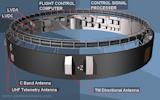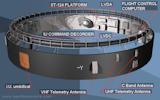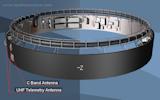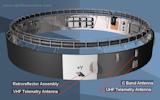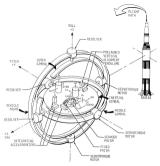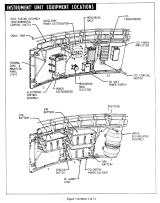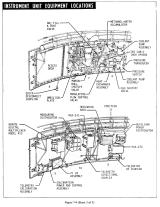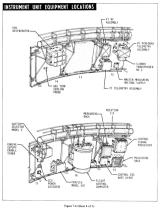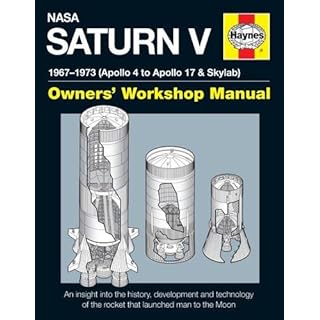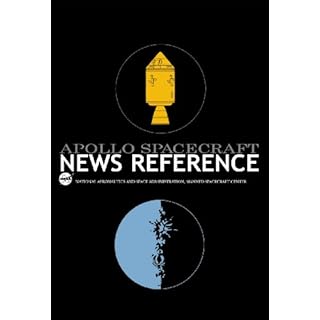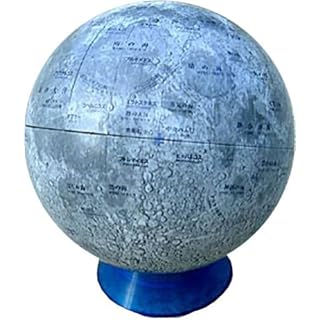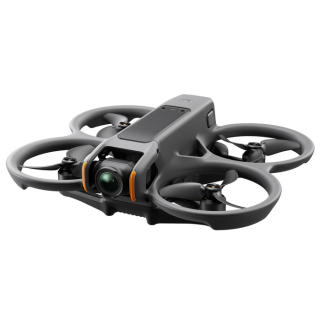Instrument Unit(IU)
- Diameter : 260in (6.604m)
- Height : 36in (0.9144m)
- Weight(Average) : 4500lb (2.04ton)
- Manufacturer:IBM (International Business Machines Federal Systems Div. Huntsville, Ala.)
Structure
As for IU of SaturnV, it was based from Saturn I's one, developed by NASA MSFC (Marshall space flight center), manufactured, assembled and tested by IBM. The electronic machine which is necessary for the data transmission, guidance, navigation, tracking were included into IU. The body is composed from three 120-degree aluminum honeycomb segments, and aluminum alloy channel rings are bonded to the top and bottom edge. And there is a spring-loaded door on the umbilical connector.

Environmental Control System
ECS (environment control system) refrigerates the machines put in IU and the top of S-IVB. The 16 cooling boards called "cold plate" are being installed at the IU and S-IVB. The antifreeze-like cooling liquid made from 60% of the methanol and 40% of the water is supplied by reservoir inside IU. Cooling of the cooling liquid is done by ground establishment before launch. About 163 seconds after launch, the sublimation-type heat exchange machine carried on IU starts the work. In such cases as a guidance computer and a flight control computer, the ST-124-M system, in the device which causes a high fever, cooling liquid circulates inside the machine as well to do cooling more efficiently. The cooling liquid and water are made to circulate by the nitrogenous gas.

Guidance and Control

When the rocket is raised in the atmosphere, guidance system does posture control so that atmospheric pressure may become the smallest. And, IU indicates jettison timing of the S-IC, S-II form amount of the fuel. During the flight by S-II, LVDC controlles the flight course takes suitable for the mission.
Instrumentation
To make it the reference of the next mission, the movement of the rocket, air pressure, a noise level, temperature, a vibration, a voltage, electric current, items which reaches several hundred are measured with the sensor, and transmitted as Telemetry to the ground. During the ground, the atmosphere flight, during the space flight, the kinds of the data that is measured are chosen in accordance with the progress of mission, more important datas are transmitted. At the time of the stage jettison, when retro (reverse jetting) rocket works, teremetry falls into the disorder with the influence. Therefore, data are recorded by tape recorder automatically between the stage jettison, and transmitted later.

Tracking System
When the RF pulse signal sent to SaturnV, transpoder on IU receives this, and answer the pulse signal as reply. The position of the rocket can be decided by receiving this in more than one ground station. In SaturnV, AZUSA, C band radar, S band command & communication system, three kinds of tracking systems are carried. Memory dumping and memory rewriting of the computer on IU can be done through this system.
Electrical System
The power is supplied from the ground equipments before the launch via the umbilical connector. Then, about 25 seconds before of the launch, four DC28V batteries carried on IU takes over this. During the flight, to save electric power, the equipments that doesn't need immediately are cut off by LVDC and LVDA.
Computers
For more information on the computers used in the Apollo project, including Saturn V's guidance & navigation, please refer to the following page.Related books and videos
-
The Apollo Guidance Computer: Architecture and Operation

Praxis July 11, 2010 USD40.46
The technological marvel that facilitated the Apollo missions to the Moon was the on-board computer. In the 1960s most computers filled an entire room, but the spacecraft’s computer was required to be compact and low power. Although people today find it difficult to accept that it was possible to control a spacecraft using such a ‘primitive’ computer, it nevertheless had capabilities that are advanced even by today’s standards. This is the first book to fully describe the Apollo guidance computer’s architecture, instruction format and programs used by the astronauts. As a comprehensive account, it will span the disciplines of computer science, electrical and aerospace engineering. However, it will also be accessible to the ‘space enthusiast’. In short, the intention is for this to be the definitive account of the Apollo guidance computer.
-
Digital Apollo: Human and Machine in Spaceflight

The MIT Press September 30, 2011 USD28.21
As Apollo 11's Lunar Module descended toward the moon under automatic control, a program alarm in the guidance computer's software nearly caused a mission abort. Neil Armstrong responded by switching off the automatic mode and taking direct control. He stopped monitoring the computer and began flying the spacecraft, relying on skill to land it and earning praise for a triumph of human over machine. In Digital Apollo, engineer-historian David Mindell takes this famous moment as a starting point for an exploration of the relationship between humans and computers in the Apollo program. In each of the six Apollo landings, the astronaut in command seized control from the computer and landed with his hand on the stick. Mindell recounts the story of astronauts' desire to control their spacecraft in parallel with the history of the Apollo Guidance Computer.
-
Saturn V Apollo Lunar Orbital Rendezvous Planning Guide

Apogee Prime 2011/07/15 USD24.95
The Saturn V Apollo Lunar Orbital Rendezvous Planning Guide is a reprint of a rare document from the early 1960s in which the whole Apollo moon landing mission was presented and illustrated. The book includes a large fold-out of the Apollo mission as well as a fold-out of the Saturn V moon rocket. It includes illustrations of early iterations of the Lunar Module, maps of the Cape Canaveral launch sites, launch schedules for all of the Apollo test flights, detailed specifications and schematics of the Saturn V launch vehicle stages, construction schedules, engine summaries, information on the VAB, mobile crawlers, Umbilical towers, a DVD and more
-
Mission Control

Gravitas Ventures 2017/07/27 USD24.99
At the heart of the Apollo space program and a remarkable decade of achievement was the team who worked in Mission Control.They were born against a backdrop of economic turmoil and global conflict. Some came from a rural lifestyle little changed from the 19th century. Others grew up in a gritty, blue-collar America of mines and smoke stacks. They ranged from kids straight out of college to those toughened by military service. But from such ordinary beginnings, an extraordinary team was born. They were setting out on what JFK called: “The most hazardous, dangerous, and greatest adventure upon which mankind has ever embarked” and through their testimony ? and the supporting voices of Apollo astronauts and modern NASA flight directors ? the film takes us from the faltering start of the program through the Mercury and Gemini missions, the tragedy of the Apollo 1 fire to the glories of the Moon landings.




